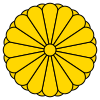
Kan'in-no-miya
Encyclopedia

Shinnoke
was the collective name for the four cadet branches of the Imperial Household of Japan, which were until 1947 entitled to provide a successor to the Chrysanthemum throne if the main line failed to produce an heir...
, branches of the Imperial Family of Japan which were eligible to succeed to the Chrysanthemum Throne
Chrysanthemum Throne
The is the English term used to identify the throne of the Emperor of Japan. The term can refer to very specific seating, such as the takamikura throne in the Shishin-den at Kyoto Imperial Palace....
in the event that the main line should die out. It was founded by Prince Naohito, the son of Emperor Higashiyama
Emperor Higashiyama
was the 113th emperor of Japan, according to the traditional order of succession.Higashiyama's reign spanned the years from 1687 through 1709.-Genealogy:...
.
Fearing extinction of the Imperial Line, Arai Hakuseki
Arai Hakuseki
was a Confucianist, scholar-bureaucrat, academic, administrator, writer and politician in Japan during the middle of the Edo Period, who advised the Shogun Tokugawa Ienobu. His personal name was Kinmi or Kimiyoshi . Hakuseki was his pen name...
proposed that a new branch of the Imperial Family be created. In 1718, retired emperor Reigen
Emperor Reigen
was the 112th emperor of Japan, according to the traditional order of succession.Reigen's reign spanned the years from 1663 through 1687.-Genealogy:...
bestowed upon his grandson the title of Kan'in-no-miya and land worth 1000 koku
Koku
The is a Japanese unit of volume, equal to ten cubic shaku. In this definition, 3.5937 koku equal one cubic metre, i.e. 1 koku is approximately 278.3 litres. The koku was originally defined as a quantity of rice, historically defined as enough rice to feed one person for one year...
. This was the first new miyake was formed since the Arisugawa-no-miya
Arisugawa-no-miya
The ' is one of the shinnōke, branches of the Imperial Family of Japan which were, until 1947, eligible to succeed to the Chrysanthemum Throne in the event that the main line should die out....
lineage in 1625.
The name Kan'in-no-miya is thought to have come from the title of Prince Sadamoto, a son of the Heian-era
Heian period
The is the last division of classical Japanese history, running from 794 to 1185. The period is named after the capital city of Heian-kyō, or modern Kyōto. It is the period in Japanese history when Buddhism, Taoism and other Chinese influences were at their height...
Emperor Seiwa
Emperor Seiwa
was the 56th emperor of Japan, according to the traditional order of succession.Seiwa's reign spanned the years from 858 through 876.-Traditional narrative:...
.
Arai Hakusei's wisdom was soon proved with the second Kan'in-no-miya, Sukehito shinnō. When Emperor Go-Momozono
Emperor Go-Momozono
was the 118th emperor of Japan, according to the traditional order of succession.Go-Momozono's reign spanned the years from 1771 through his death in 1779....
died, he had only a single daughter. Sukehito's son was chosen to become Emperor Kōkaku
Emperor Kokaku
was the 119th emperor of Japan, according to the traditional order of succession.Kōkaku's reign spanned the years from 1780 through 1817.-Genealogy:...
.
The Kan'in House went extinct upon the death of its 5th head, Prince Kan'in Naruhito
Prince Kan'in Naruhito
was the 5th head of the Kan'in-no-miya line of shinnōke cadet branches of the Imperial Family of Japan.He became the 5th head in 1828 after the passing of Prince Kan'in Tatsuhito....
, in 1842, but was revived by Emperor Meiji
Emperor Meiji
The or was the 122nd emperor of Japan according to the traditional order of succession, reigning from 3 February 1867 until his death...
, who assigned the name to Prince Kotohito, 16th son of Prince Fushimi Kunie (one of the other shinnoke houses).
The line went extinct again with the death of his son, Kan'in Sumihito (formerly Kan'in-no-miya Haruhito shinnō) in 1988.
| Name | Born | Succeeded | Resigned | Died |
| 1 |
|-
| 2 || || 1733 || 1753 || . ||1794
|-
| 3 || || 1768 || 1794 || . ||1818
|-
| 4 || || 1792 || 1818 || . ||1824
|-
| 5 || || 1818 ||1828 || . || 1842
|-
| 6 || || 1865 || 1872 || . || 1945
|-
| 7 || || 1902 || 1945 || 1947 || 1988
|-
|}

